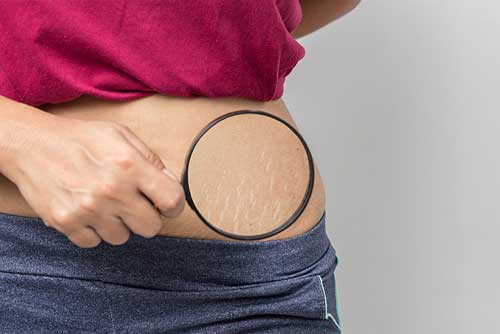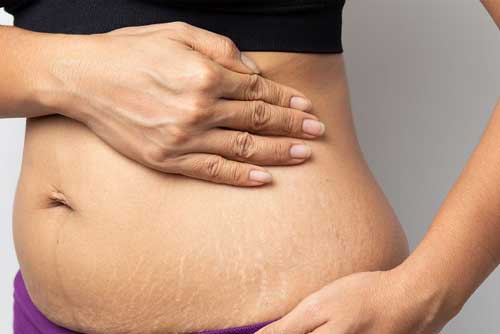+91 8275066599
Book an Appointment
info@myaesthetic.in
Book an Appointment
3/26,27, Gokhale Nagar Road
Pune - 411016, MH, India
Stretch Marks Treatment
My Aesthetics Stretch Marks Treatment Clinic in Shivaji Nagar, Baner. Stretch marks occur when there is rapid growth in areas of the body, which stretch the skin and result in thin purple or white lines. They are completely harmless but, unlike other marks, rarely go away entirely without intervention. Having stretch marks can lead to a lack of self confidence for many, but are easily remediable with treatments such as skin peels and laser treatments.
-
Fractional Laser
Non-Ablative Fractional Laser technology is unrivalled in its ability to remove the years, and treat skin imperfection, damage and signs of aging.
Microneedling RF
CO2 Laser



-
What exactly is a stretch mark?
Stretch marks fade with time; however, treatment may make them less noticeable more quickly.A stretch mark is a type of scar that develops when our skin stretches or shrinks quickly. The abrupt change causes the collagen and elastin, which support our skin, to rupture. As the skin heals, stretch marks may appear.
Not everyone develops these narrow bands on their skin. Fluctuating hormone levels seem to play a role. You may also have a higher risk if people in your family get stretch marks.
If you develop stretch marks, you’re most likely to do so during these times:
- Growth spurts that happen in puberty
- Pregnancy
- Rapid weight loss or gain
- Weight training when you have rapid muscle growth
Applying a corticosteroid to your skin for a long time can also cause stretch marks. If you have Cushing’s disease or Marfan syndrome, you may see stretch marks.
When stretch marks first appear, they tend to be red, purple, pink, reddish-brown, or dark brown, depending on your skin color. Early stretch marks may feel slightly raised and can be itchy.
In time, the color fades and the narrow bands sink beneath your skin. If you run your finger over a mature stretch mark, you often feel a slight depression.
-
What can get rid of stretch marks?
Like any scar, stretch marks are permanent, but treatment may make them less noticeable. Treatment can also help alleviate the itch.
If you’re pregnant or breastfeeding, check with your doctor before treating stretch marks. Some products contain ingredients, such as retinol, that can harm your baby.
It’s important to understand that no single treatment works for everyone — and many products don’t seem to work at all. Here’s what researchers have discovered about the many treatments for stretch marks.
Stretch mark creams, lotions, and gels: Researchers have studied many of the creams, lotions, and gels sold to treat stretch marks. While no one product seems to help all of the time — and some don’t seem to help at all — researchers have discovered some helpful hacks.
If you want to try one of these creams, lotions, or gels to fade stretch marks, be sure to:
- Use the product on early stretch marks. Treatment seems to have little effect on mature stretch marks.
- Massage the product into your stretch marks.Taking time to massage the product gently into your skin may make it more effective.
- Apply the product every day for weeks.If you see results, they take weeks to appear.
Home remedies: In studies, popular home remedies have not worked. Researchers found that none of the stretch marks faded when people massaged almond oil, cocoa butter, olive oil, or vitamin E into their stretch marks.
Tanning cannot get rid of stretch marks. When you tan, stretch marks become more noticeable because they don’t tan.
Self-tanner: While tanning can make stretch marks more noticeable, a self-tanner can camouflage stretch marks — both early and mature ones. A self-tanner cannot get of rid of stretch marks.
Prescription medicine you apply to your skin: In studies, two ingredients seem to offer some relief:
- Hyaluronic acid
- Tretinoin
In two large studies, applying hyaluronic acid to early stretch marks made the stretch marks less noticeable.
Tretinoin is a retinoid, which may also make early stretch marks less noticeable. In one study, people who applied this prescription cream every night for 24 weeks had less noticeable stretch marks. Those who didn’t apply the cream saw their early stretch marks grow. Other studies have found similar results.
Retinol, another type of retinoid, may also help fade early stretch marks.
Procedures that dermatologists perform: Dermatologists use the following procedures to make stretch marks less noticeable, but none of these can get rid of stretch marks:
- Chemical peel
- Laser therapy
- Microdermabrasion
- Radiofrequency
- Ultrasound
To give you the best results, Dr Madhuri may use more than one procedure. It’s common to have some redness and swelling after a procedure. The redness and swelling tend to disappear in a few hours or days.
-
Carbon Dioxide Laser Resurfacing
Carbon dioxide lasers can precisely remove thin layers of skin with minimal damage to the surrounding structures. These lasers treat sun damage, wrinkles, scars, warts, birthmarks and other skin conditions.
What is carbon dioxide laser resurfacing?
Carbon dioxide laser resurfacing is used to treat a variety of skin conditions. Carbon dioxide lasers very precisely remove thin layers of skin with minimal heat damage to the surrounding structures.
-
Carbon Dioxide Laser Resurfacing
Carbon dioxide lasers treat:
- Wrinkles (rhytides).
- Photodamage.
- Scars.
- Warts.
- Linear epidermal nevi (birthmarks).
- Rhinophyma (enlarged oil glands on the nose).
The ability to rejuvenate sun-damaged, wrinkled skin has been revolutionized by this new technology. Carbon dioxide laser is useful for decreasing facial lines and scars and stretch marks.
What can be expected during and after carbon dioxide laser resurfacing?
Carbon dioxide laser resurfacing is usually performed on an outpatient basis, using local anesthesia.
The areas to be treated are numbed with a local anesthetic. Wrinkles around the eyes, mouth or forehead may be treated individually, or a full-face laser resurfacing may be performed.
This wound care is intended to prevent the forming of any scabs, which can increase the chance of scarring and prolong the healing time.
In general, the areas heal in 10 to 21 days, depending on the nature of the condition that was treated and the intensity of the laser settings. The stronger the settings, the longer the recovery time.
Once the areas have healed, you can wear oil-free makeup to camouflage the pink-to-red color that is generally seen after laser resurfacing. The redness in the laser-treated sites generally fades in two to three months, but may take as long as six months to disappear.Patients with darker skin tones have a greater risk of healing with darker pigmentation (hyperpigmentation), although anyone can be affected by this condition after laser treatment. This may be minimized by the use of a bleaching agent before surgery. It also may be reduced with the continued use of this agent after healing.
You should avoid sun exposure for four weeks before laser treatment and liberally apply sunscreens pre- and post-procedure.
RISKS / BENEFITS
What are the possible risks and side effects of carbon dioxide laser resurfacing?
- Milia, which are small white bumps or cysts, may appear in the laser-treated areas during healing. Acne flares may occur after laser resurfacing. This may resolve on its own, or can be treated with conventional acne therapies.
- Hyperpigmentation, and more rarely, hypopigmentation, may result in the laser-treated areas. In general, the hyperpigmented areas may be treated with bleaching cream to ease fading of the pigment. Hypopigmentation is more difficult to treat.
- Reactivation of a herpes simplex cold sore may occur, especially after laser resurfacing around the mouth. This can be prevented by giving an antiviral medicine prior to the surgery and continuing it for seven to 10 days post-procedure.
- Bacterial infections can be prevented by taking an antibiotic prior to the surgery and continuing for seven to 10 days post-procedure.
- Scarring, although rare, may occur in laser-treated areas.
- Quitting smoking is highly recommended because of its documented harmful effects on the healing process.
RECOVERY AND OUTLOOK
How do I care for my skin after carbon dioxide laser resurfacing?
Daily sunscreen application is necessary after healing to protect the newly laser-resurfaced skin. A broad-spectrum sunscreen is recommended, which screens both ultraviolet B and ultraviolet A rays. Use a sunscreen specifically formulated for use on the face with a sun protection factor (SPF) of at least 30.
Liberal moisturizer application is also recommended after healing. You can resume application of Retin-A and/or glycolic acid products approximately six weeks after the procedure, or as directed by your healthcare provider.
-
Why do people get stretch marks?
Stretch marks develop on parts of the body experiencing rapid growth, for example during growth spurts as a teenager or throughout pregnancy. Common areas that people develop stretch marks are: the stomach, upper arms, buttocks, thighs, breasts and shoulders (in bodybuilders).
Telltale signs that you are developing stretch marks are: the skin feeling stretched, thin and becoming increasingly itchy. As the skin stretches, the middle layer of skin called the dermis tears, allowing the deeper skin layers to show through as thin purple lines. As stretch marks grow older, they go from thin, purple lines to silvery-white ones.
Pregnancy is one of the most common times of a woman's life that stretch marks appear. They usually appear in the later stages of pregnancy, and often emerge across the tummy as it grows, or across breasts and thighs.
Rapid weight gain in any area of the body can also result in having stretch marks. Common factors resulting in weight gain include: the ageing process (where muscle mass tends to become less), diabetes treatment, steroid treatment, excess tiredness and numerous hormonal imbalances.
fix an appointment

